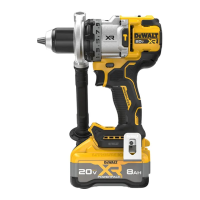15
ENGLISH
15
Tool Connect™ Chip (Fig. I)
WARNING: To reduce the risk of serious personal
injury, turn unit off and remove the battery pack
before making any adjustments or removing/
installing attachments or accessories. An accidental
start‑up can causeinjury.
Your tool is Tool Connect™ Chip ready and has a location for
installation of a Tool Connect™ Chip.
Tool Connect™ Chip is an optional application for your
smart device (such as a smart phone or tablet) that connects
the device to utilize the mobile application for inventory
management functions.
Refer to Tool Connect™ Chip Instruction Sheet for
moreinformation.
Installing the Tool Connect™ Chip
1. Remove the retaining screws
23
that hold the Tool
Connect™ Chip protective cover
24
into thetool.
Optional Accessories
WARNING: Since accessories, other than those offered
by DeWALT, have not been tested with this product, use
of such accessories with this tool could be hazardous.
To reduce the risk of injury, only DeWALT‑recommended
accessories should be used with thisproduct.
Consult your dealer for further information on the
appropriateaccessories.
Cleaning
WARNING: Electrical shock and mechanical hazard.
Disconnect the electrical appliance from the power source
beforecleaning.
WARNING: To ensure safe and efficient operation,
always keep the electrical appliance and the ventilation
slotsclean.
WARNING: Never use solvents or other harsh chemicals
for cleaning the non‑metallic parts of the tool. These
chemicals may weaken the materials used in these parts.
Use a cloth dampened only with water and mild soap.
Never let any liquid get inside the tool; never immerse any
part of the tool into aliquid.
Ventilation slots can be cleaned using a dry, soft non‑metallic
brush and/or a suitable vacuum cleaner. Do not use water or
any cleaning solutions. Wear approved eye protection and an
approved dustmask.
Lubrication
Your power tool requires no additionallubrication.
satisfactory operation depends upon proper tool care and
regularcleaning.
WARNING: To reduce the risk of serious personal
injury, turn tool off and disconnect battery pack
before making any adjustments or removing/
installing attachments or accessories. An accidental
start‑up can causeinjury.
The charger and battery pack are notserviceable.
MAINTENANCE
Your power tool has been designed to operate over a long
period of time with a minimum of maintenance. Continuous
5. Hold tool firmly with both hands to control the twisting
action of thedrill.
6. IF DRILL STALLS, it is usually because it is being overloaded
or improperly used. RELEASE TRIGGER IMMEDIATELY,
remove drill bit from work, and determine cause of stalling.
DO NOT CLICK TRIGGER ON AND OFF IN AN ATTEMPT TO
START A STALLED DRILL — THIS CAN DAMAGE THEDRILL.
7. To minimize stalling or breaking through the material,
reduce pressure on drill and ease the bit through the last
fractional part of thehole.
8. Keep the motor running when pulling the bit back out of a
drilled hole. This will help preventjamming.
Drilling in Metal
Start drilling with slow speed and increase to full power while
applying firm pressure on the tool. A smooth even flow of metal
chips indicates the proper drilling rate. Use a cutting lubricant
when drilling metals. The exceptions are cast iron and brass
which should be drilleddry.
NOTE: Large holes (5/16" to 1/2" [7.9 mm to 13mm]) in steel
can be made easier if a pilot hole (5/32" to 3/16" [4 mm to
5mm]) is drilledfirst.
NOTE: When using a cutting lubricant, be sure not to get the
lubricant on thetool.
Drilling in Wood
Start drilling with slow speed and increase to full power while
applying firm pressure on the tool. If nails are likely to be
encountered, appropriate drill bits capable of withstanding nail
strikes should be used. Work that is apt to splinter should be
backed up with a block ofwood.
Hammerdrilling
IMPORTANT: Use carbide‑tipped or masonry bits rated for
percussion drillingonly.
1. Select the desired speed/torque range using the speed
selector
8
to match the speed and torque to the planned
operation. Turn the mode selection collar
5
to the
hammerdrillsymbol.
2. Pull the trigger, applying just enough pressure on the
hammer to keep it from bouncing excessively or "rising" off
the bit.
Recommendations for Hammerdrilling
• Too much force will cause slower drilling speeds,
overheating, and a lower drillingrate.
• A smooth even flow of material indicates the proper
drillingrate.
• Drill straight, keeping the bit at a right angle to the work. Do
not exert side pressure on the bit when drillling as this will
cause clogging of the bit flutes and a slower drillingspeed.
• When drilling deep holes, if the hammer speed starts to
drop off, pull the bit partially out of the hole with tool still
running to help clear debris from thehole.

